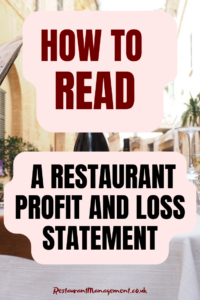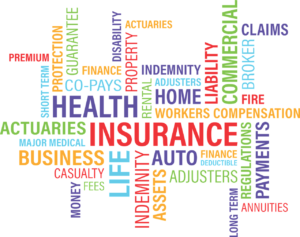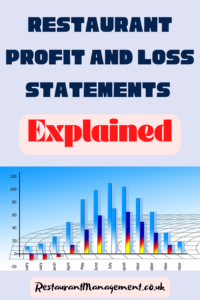First Published on: 24 Aug 2022
Restaurant Profit and Loss Statement: Understanding and Creating Them
In the world of restaurants, where flavours and experiences take centre stage, there’s an often-overlooked backstage secret that separates thriving establishments from the rest: mastering the art of the restaurant profit and loss statement. As a restaurant owner or manager, you might be an expert at crafting culinary delights and curating memorable dining atmospheres, but it’s the proficiency in deciphering these financial blueprints that can make or break your culinary venture.
Beyond the kitchen and the front of the house, behind every successful restaurant lies a strategic grasp of the profit and loss statement—a roadmap to your business’s financial health. In this article, we’ll embark on a journey to demystify the significance of these financial documents. We’ll unravel their secrets, revealing how they empower you to make informed decisions, optimize operations, and ensure the financial success of your culinary enterprise. So, let’s dive in and explore the financial recipe for restaurant prosperity.
Profit And Loss For Restaurant
A restaurant profit and loss statement, often referred to as a restaurant P&L, shows your business’ costs and revenue (net profit or loss) during a specified period of time. In other words, your P&L functions as a bank statement for your hospitality organization to monitor your company’s financial health.
Calculating the profitability of most food service establishments comes down to basic fundamental business components: increasing sales or margins (revenue) and reducing costs or expenses. Statistics show that 50% of new restaurants go out of business by year 5 because they fail to make a profit.

A restaurant profit and loss statement is a pretty common financial reporting method for determining your restaurant’s profitability; where this might get a little confusing is knowing what actually to include in your restaurant’s P&L statement.
As a restaurant general manager or owner, you must be proficient in how to read a restaurant P&L. This restaurant P&L guide will walk you through the essential steps for creating a restaurant P&L report.
So, whether you choose to have a qualified accountant generate your P&L or you use accounting software to create it yourself, you will have a better understanding of reading and reviewing one.

What Is Your Biggest Accounting Issue?
- Are you behind on your books?
- Not sure where your cash flow is going each month?
- Need help with financial reporting and actionable analysis?
- Have problems or inaccuracies with your accounting systems?
- Need help with getting food and labour costs in control?
No problem, we have seen it all; questions like these can keep even the best restaurateurs and chefs up at night.
The difference between well-managed high-end restaurants and not-so-well-managed restaurants is the level of attention they pay to the numbers. How do you make a P&L for a restaurant? As a successful restaurant manager, you must learn to make a P&L part of your day-to-day operational duties.
What Should A Restaurant Profit And Loss Statement Include?
A “profit and loss for a restaurant” will usually consist of three main components:
- The P&L will include a breakdown of your sales and revenue.
- The next section will list all your costs of goods sold (COGS).
- The last section will include operating expenses, such as the cost of restaurant insurance and occupancy expenditures.
Another thing to mention is that the restaurant labour cost is usually listed as a separate expense between COGS and operating expenses. To figure out where your largest profits or losses have occurred, get more granular and break down your revenue and costs into smaller, more specific sections.

Ways To Create A Restaurant Profit and Loss Statements
Also, every business is different, so you can customize your restaurant P&L to your company’s needs. You can also make your restaurant profit and loss statement as simple or elaborate as you want, but remember it will be more helpful to understand your accounts if you provide details of the costs and gains most relevant to your establishment.
How To Read A Restaurant P&L
Revenue
Revenue is the profits you earn from selling items and goods to your customers. Most restaurants will make their highest profits from their sales of food and beverages, but some chains will have other forms of revenue. Make sure you list each form of income separately on your restaurant income statements as well as your P&L statement.
Food and Beverage Sales
You can break line items down into smaller subset sections under food, beer, wine and coffee. Depending on what kind of food sales hospitality business you have, one section may be more profitable than others for you. If you run a boutique coffee shop in Brooklyn, your coffee sales will likely be higher than selling food items. If you are a high-end steak house, you may generate more profits from food dishes than you do from selling wine.
Other Business Ventures
Merchandise Sales: this could include any items that are sold or function as promotions for your restaurant. Merchandise could include gift cards, t-shirts, mugs, or hats. The Hooters chain does a lot of merchandising, sales, and promotion.
Catering: this is a great way to reach out to a new neighbourhood and introduce people to your cuisine. This could include doing high-end special events or private parties, and it could include selling snacks for a fundraiser or local school event. If your restaurant does any catering, make certain to list it as a separate income item on your P&L statement.
Costs
Your restaurant’s costs should include any type of expense, such as inventory purchases, insurance costs, and employee paychecks. The three main expenditures you will encounter as a manager include the cost of goods sold, restaurant labour costs, and restaurant operating expenses, which are usually listed as separate line items on the P&L statement.
Cost of Goods Sold
The cost of goods sold (COGS) metric, sometimes referred to as cost of usage, records the amount of money you spend on food ingredients and beverages that you supply to your customers.
Also, menu pricing is an important aspect to understand, especially if you are competing with many other similar food establishments. Some restaurants use a tactic called the portion control method to decrease the amount of inventory they use each week by small amounts, which helps them to keep more in stock for the next week and thus lowers their COGS.
Restaurant Labour Costs
The wages and salaries of all your staff, from your head chef to your waiters, will determine your labour costs. This can include payroll taxes, labour worker’s compensation, and group insurance benefits. The most important element to balance, which will help control your labour cost, is to figure out exactly how many employees you need each week in order to provide effective service without over-scheduling.
Depending on how busy you are, every restaurant needs a chef, some servers, and a hostess. This category offers significant cost containment opportunities.
Labour costs can be improved with knowledge of a required resource allocation to demand, over-time prevention, and continuous improvements in productivity – employee or physical components of the business, e.g., labour-saving equipment, optimized floor plans, etc.
A smart restaurateur will figure out how to have some control over the amount spent on labour expenses, making a determination on which employees are an absolute necessity to have on the payroll full-time.
Restaurant Operating Expenses
Operating expenses will include costs on everything from tablecloths to rent. Now, depending on what type of hospitality business you have, your expenses vary immensely. Below is a chart listing some of the most common restaurant expenses you should account for, but some of these may or may not be the most relevant to your type of eatery or bar.
Occupancy Expenses
These costs or expenses include the nuts and bolts of running your business, which include property taxes, utilities, interest, depreciation, rent, and waste removal. Keep in mind to carefully review your leasing agreement because some expenses may vary, whereas others, like waste removal, maybe a fixed cost. Another thing to be on the lookout for is possible unforeseen expenses like equipment or even building repairs that are a necessity for the safety and success of the business.

Restaurant Insurance Cost
Insurance is a must-have element when running a business, and it can cost thousands of dollars a year based on the extent of the risk coverage you want. Your restaurant’s insurance costs may include coverage for worker’s comp, business crimes, general liabilities, loss of income, equipment breakdown or even property damage. It is recommended you shop around from a few vendors to see all your options.
Controllable Expenses
You can think of miscellaneous costs as any daily expense that is necessary to your restaurant’s business, such as the restocking of linen uniforms, cleaning supplies, napkins, paper cups, replacing glassware, etc. You can also include advertising here.
Some expenses will obviously vary depending on the type of establishment you run. As an example, when comparing a 5-star Mayfair restaurant to a fast food chain, the 5-star restaurant will invest in more fancy chinaware, and the fast food chain will purchase more disposable cups.
Prime Cost
The prime cost is the sum of a restaurant’s food, beverage, and labour costs. Some restaurant owners will consider this their profitability cost benchmark number on their P&L statement. Because the prime cost bundles the two largest cost categories, it represents a key indicator of whether the company will be profitable in the next reporting period.
Prime cost is also a direct reflection of how management is controlling food, beverage, and labour costs on a daily basis throughout the reporting period. A successful restaurant will keep its prime cost at 65% or lower.
Related articles:
How To Improve Restaurant Profits
Restaurant Inventory Management System
Restaurant Profit And Loss Statement UK
At the bottom of the P&L statement, you must list your net profit or loss based on your costs and revenue. You calculate your net profit or loss by subtracting both the labour costs and the operating costs from your gross profit. Your revenue obviously needs to be higher than all your combined costs for you to generate a profit.
Here is an example of what a restaurant’s P&L statement may look like:
A Restaurant Profit And Loss Statement Examples
| Sample P&L Statement | £ | % |
| Budget Turnover | 800000 | |
| Actual Sales Turnover | 750000 | |
| Sales | ||
| Food | 555000 | 74% |
| Liquor | 47250 | 6.30% |
| Beer | 18750 | 2.50% |
| Wine | 129000 | 17.20% |
| Total Sales | 750000 | 100 |
| Cost of Sales | ||
| Food | 155218 | 28% |
| Liquor | 8741 | 18.50% |
| Beer | 4688 | 25.00% |
| Wine | 43989 | 34.10% |
| Total Cost of Sales | 213000 | 28.40% |
| Gross Profits | 537000 | 71.60% |
| Labour Cost | ||
| Management | 48750 | 6.50% |
| Direct | 171000 | 22.80% |
| Employee Benefits | 39750 | 5.30% |
| Total Labour Cost | 105600 | 34.60% |
| Total Prime Cost | 4750000 | 63.00% |
| General Expenses | ||
| Laundry and Linen | 16500 | 2.20% |
| Equipment replacement | 9750 | 1.30% |
| Supplies | 4500 | 0.60% |
| Vehicle | 3000 | 0.40% |
| Advertising | 2250 | 2.30% |
| Utilities | 19500 | 2.60% |
| Office Supplies | 4500 | 0.60% |
| Data processing | 6750 | 0.90% |
| Telephone | 3650 | 0.50% |
| Travel | 3000 | 0.40% |
| Insurance | 10500 | 1.40% |
| Credit Card expenses | 18000 | 2.40% |
| Cash (over) short | 0 | 0.00% |
| Accounting | 6000 | 0.80% |
| Legal | 1500 | 0.20% |
| Business Rates | 2250 | 0.30% |
| Miscellaneous | 2250 | 0.30% |
| Repairs | 13500 | 1.80% |
| Rent | 41250 | 5.50% |
| Interest | 6000 | 0.80% |
| Depreciation | 19500 | 2.60% |
| Total Expenses | 194150 | 27.90% |
| Net Profit/Loss | 69000 | 9.10% |
What is a good profit margin for a restaurant?
Globally, the average profit margin for the restaurant industry is around 2-6%. However, there are data points that range from zero to 15% annually.
Conclusion
Remember, your profit and loss statement should include only what is most relevant to your particular culinary business. Bookkeeping Chef’s software, platform makes it easy to create and read accurate P&L statements so that you can understand your financials and grow your business.
Remember that successful businesses use and rely on data to make decisions. To understand how to increase the profitability of your restaurant, you need first to have a clear sense of how your restaurant is currently performing. How much are you spending on labour?
How much does it cost you to create each of your menu items? Which menu items are the best and worst sellers? After considering your controllable costs like payroll and food costs, is there enough money to cover your overhead costs?
By regularly creating income statements and tracking your prime cost over time, you will start to recognize trends and areas that need more attention so you can make the appropriate adjustments.
How to Improve Restaurant Profits and Increase Restaurant Sales
Frequently Asked Questions and Answers
What is profit and loss in a restaurant?
In a restaurant, the profit and loss statement, often called P&L, outlines the revenue, costs, and expenses incurred during a specific period. It provides a comprehensive overview of the restaurant’s financial performance, showcasing whether the business is profitable. This statement typically includes sales, food and beverage costs, operating expenses, and net profit. Monitoring the P&L is crucial for restaurant owners to assess profitability, identify areas for cost control, and make informed financial decisions.
How can one compose a profit and loss statement for a restaurant?
To craft a profit and loss statement for a restaurant:
- Initiate the process by delineating the revenue section.
- Specify the sales generated from food, beverages, and other sources of income.
- Deduct direct costs like food and beverage expenses, followed by operating expenses such as labour, rent, utilities, and marketing.
Subtracting these costs from revenue yields the operating profit. Include non-operating items like interest and taxes to calculate the net profit. Use accounting software or spreadsheets for accuracy and consistency. Regularly update and analyse the P&L to gauge financial health and make strategic adjustments for improved profitability.
What should I look for in a restaurant P&L?
When reviewing a restaurant’s profit and loss statement, focus on key indicators. Monitor gross profit margin to assess profitability on core operations. Examine labour costs as a percentage of sales to evaluate workforce efficiency. Scrutinise operating expenses for potential areas of cost reduction. Keep an eye on net profit to gauge overall financial success. Additionally, compare current P&L statements to historical data for trends and benchmark against industry standards to ensure competitiveness. A thorough understanding of these elements empowers restaurant owners to make informed decisions and optimise financial performance.
What is profit and loss in the food industry?
Within the food industry, the profit and loss statement (P&L) serves as the financial document that outlines the revenue and expenses accrued over a defined period. This comprehensive document enables businesses in the food industry to assess their financial health, identifying areas of profitability and potential cost-saving measures. The P&L statement encompasses various components such as sales, cost of goods sold (COGS), operating expenses, and net profit. Analysing this statement is crucial for food industry professionals to make strategic decisions, allocate resources efficiently, and ensure sustained financial success in a competitive market.



